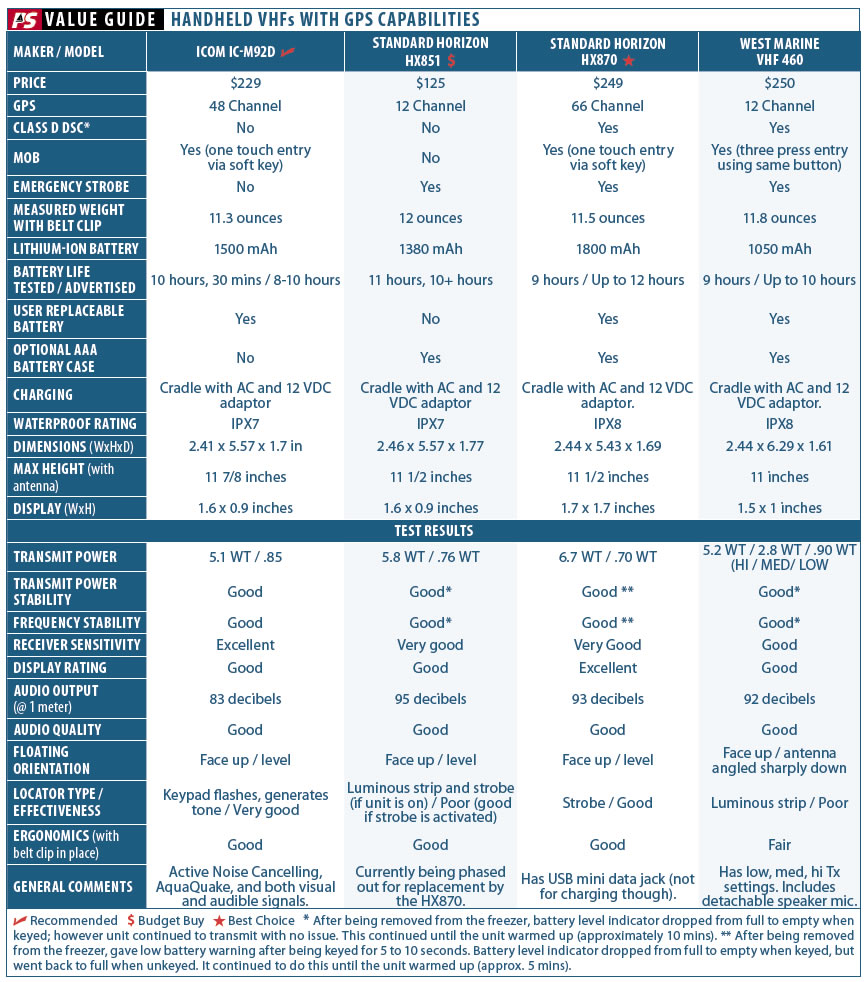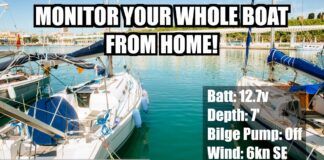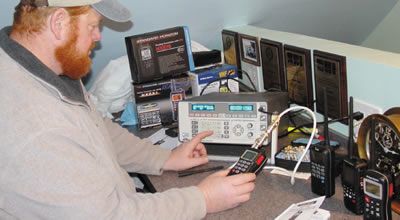
The big advantage of handheld VHF radios as compared to their fixed-mount brethren has always been portability. Its portability that allows them to serve as the primary radio on smaller boats (a dinghy for example), as an emergency backup (or secondary working unit) to a fixed unit, or even as a way to summon help during an unexpected swim. While reduced range (due to their shorter antenna height and lower transmit power) have been acceptable tradeoffs for portability, modern handheld VHF radios continue to keep pace with the many other features provided by fixed-mount VHFs.
For our most recent test, we focused on units that touted the latest features in handheld VHF radios, including longer battery life, reduced weight, positive flotation, internal GPS, and digital selective calling (DSC) capabilities like the ability to send an instant DSC alert to rescue authorities such as the U.S. Coast Guard.

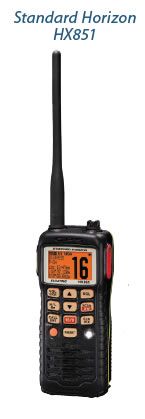
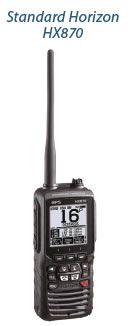
West Marine VHF460

What We Tested
Our current test group consisted of four radios. Icom, a global company whose product line includes communications equipment and products based in the marine, avionics, land mobile and wide-band receiver industries, supplied its M92D, the top-rated VHF in our last look at handheld VHF radios (see PS July 2013 online). Marine electronics icon Standard Horizon submitted the HX851 along with their latest unit, the HX870. Marine retail giant West Marine provided their VHF460.
The units in our test group shared a number of common features, such as channel scanning, channel 16 quick select, NOAA weather radio, and of course, dual power modes (1-watt and 5-watt operation). There were a number of unique functions as well. Special features found in one or more radios included: remote microphone options, mini USB data jacks, automatic strobes, flashing keypads, and alert tones to help locate them if dropped overboard.
For details on the test protocol, see the accompanying How We Tested.
Icom IC-M92D
The M92D is billed by Icom as the worlds first active noise-cancelling handheld, a feature that quiets background noise (up to 90 percent per Icom) on both outgoing and incoming calls.
The M92D has 14 buttons on the front panel, a key button on the left side, and a DSC alert button on the back protected by a spring-loaded red cover.
Testers found operation of the menu system to be straightforward and fairly intuitive. The display screen, while fairly large, is tasked with showing a lot of information: location, menu selections, etc. Although the display is crisp and clear, its a busy screen, and some of the text appears pretty small. In other words, keep your cheater glasses handy.
Equipped with a 48-channel internal GPS, an internal compass, and navigation functions, the M92D can also serve as a back-up navigation unit in a pinch. Registration and entering a Maritime Mobile Service Identity (MMSI) number is required to initiate the use of DSC functions (distress, position requests, individual, all ships, group, and test calls, etc.). The M92D can store up to 100 DSC addresses, up to 10 characters per name.
The M92D can store and navigate to up to 50 waypoints with just a couple of button presses. It can also store and navigate to that all-important man-overboard (MOB) waypoint. Although there is no dedicated man-overboard button, users can also prioritize the MOB selection key for one-touch entry.
The M92D allows users to quickly clear the speaker and microphone of water using Icoms AquaQuake feature. Press two keys (or save it as a favorites key) and the radio emits a low-frequency sound blast of several seconds designed to clear water from the grill. This is a great feature, particularly for those who find themselves in the water and needing to clear microphone and speaker in a hurry.
When dropped in water, the M92D floats in a face-up position. The entire keypad flashes, and it produces an audible beep alarm as an aid for retrieval in the dark. Testers found this flashing keypad was easier to spot than the single flashing LED found on some other units. The locator tone is a nice touch, but with the speaker awash it wasnt loud enough to be of much practical use.
The M92D package ships with a charger tray, AC charger power cord, belt clip, DC charger power cord, wrist strap, screws to permanently mount the cradle, and an instruction manual.
When we conducted our 2013 test, the M92D was advertised as being a Class D DSC radio, a term that means the radio has a second receiver dedicated solely to the emergency channel. Icom later retracted that claim, which means it is now advertised as a DSC radio, but not Class D.
Bottom line: Although held back a bit by the lack of Class D DSC operation, this is still an extremely versatile, feature-laden radio. We give it a Recommended rating.
Standard Horizon HX851
A workhorse of the Standard Horizon lineup, the HX851 touts a polycarbonate housing and die-cast chassis thats ergonomically shaped with a rubberized armor for a non-slip grip. The keypad has 10 buttons on the front panel, a key button on the left side, and a DSC alert on the right side protected by a red, rubber flap secured at one end.
Featuring a 12-channel GPS receiver, the HX851s GPS capabilities include storage of up to 200 waypoints, navigation to a waypoint, and DSC functions. These include position request, position report, and navigation to a DSC position.
Scan modes include programmable scan, programmable priority scan, and dual watch.
The full dot-matrix, backlit, segmented LCD shows channel names, radio/position, speed over ground (SOG), course over ground (COG), waypoint navigation, and compass displays. Volume and squelch levels are also displayed.
Other features include a preset key with 10-channel storage, NOAA weather with weather alert, and a submersible speaker microphone jack for connecting optional accessories (an external speaker microphone, headset, or earbud). It comes with a charging bay with adaptors for both 12-volt DC and 110-volt AC power sources, and an instruction manual.
A glow-in-the-dark gasket helps users locate the radio in the dark. Testers found it to be better than nothing, but still of limited benefit, particularly when compared to more active locating aids (flashing strobe, keypad, etc). The HX851 also has a water-activated strobe (which makes the unit much easier to locate), however it only works if the unit is turned on when it is dropped in the water.
Overall, testers were impressed with the HX851, but there was room for improvement. One desired upgrade would be a dedicated MOB button. Another would be easier waypoint entry, which is a tedious process requiring the use of the up/down and enter buttons. The manual lists 18 steps for storing a single waypoint.
According Standard Horizon Executive Vice President Jason Kennedy, the HX851 is being phased out over the first half of 2015 and will eventually be replaced by the HX870.
Bottom line: Although the end of the line is in sight, the HX851 is still a solid choice that brings a lot to the table. It gets our pick for Budget Buy.
Standard Horizon HX870
Building on the success of its predecessor (the HX851), the HX870 is Standard Horizons effort to take handheld VHF radios to the next level of performance. A fully compliant Class D DSC radio, the HX870 is constructed of a polycarbonate housing and die-cast chassis. It has a 13-button front keypad (three of which control soft keys). Buttons on the left side include power, transmit, and a single switch that toggles between squelch and volume select. On the right side is the data port and DSC button, both of which are protected by their own spring-loaded plastic flaps.
Operational functions include DSC calling, position sharing, waypoint and route navigation, and navigation to a DSC distress call. It has an advertised 6 watts of transmit power and features an 1800 mAh Li-Ion battery.
The HX870 is capable of saving up to 200 waypoints and 20 routes, each of which can be selected for navigating to via the radios compass page, all while viewing speed, course, bearing, and distance to go. The compass page can also display the position of up to nine vessels in proximity to you via the new group monitoring (GM) feature. Advanced features include a full dot-matrix display with channel names, position request, position report, 10-channel preset key selection, USB data port, and GPS position logger.
The HX870 also sports a water-activated SOS strobe light, which activates when the unit is dropped in the water (even if the radio is turned off at the time). Other features include NOAA weather with Weather Alert, programmable memory, priority scan, and dual- and tri-watch scan functions.
The first standout feature youll notice with the new HX870 is the display. Its almost twice as large as the other radios in our test group; the upgrade is akin to stepping up from an old flip-phone to a smart phone. This bigger screen not only means larger, easier-to-read text, but also easier-to-read navigation graphics as well. The compass screen is a good example of this. The bright, blueish-white illuminated screen was clear and easy to read in all light conditions.
Testers also like the intuitive menu interface. Left and right arrow keys allow you to easily scroll through the soft button icons located at the bottom of the screen, which are then selected using one of three hard keys. Another big plus is the MOB soft key, which allows users to enter a position with a single button push.
Although the HX870s 1800-mAh, Lithium-ion battery was the largest of the group, it didnt blow the competition away in tests. Battery performance was on par with the smaller units. However, the HX870 has a battery-saver mode that we didnt use in tests. (Theres also a GPS power saving mode.) One thing that testers missed having was a charge-status indicating light on the charging bay. The screen displays charge progress, but that red and green light is a simple feature that makes it easier to determine at a glance.
The HX870 comes with a charging bay (with both 12-volts DC and 110-volts AC power adaptors), mini-USB data cable, alkaline battery tray, and instruction manual.
Bottom line: A solid radio that covers all the bases for a reasonable price, the HX870 is our Best Choice.
West Marine VHF460
The VHF460, made by Uniden for West Marine, features a polycarbonate chassis, dot-matrix display, an SOS strobe light, and a power boost key for instant 6-watt transmitting power. The keypad has eight buttons on the front panel, power on, push-to-talk key; the power boost button is on the left side, and a DSC alert button is on the right side protected by a red, rubber flap secured at one end.
Class D DSC call functions include distress, individual, group, all ships, urgency, safety, and DSC test. The VHF460 can save up to 100 GPS waypoints and provide an NMEA 0183 output to other electronics (such as your autopilot) from the charging cradle.
The VHF460 comes with an auxiliary battery tray, NMEA charging cradle (with AC and DC adapters), an external speaker/microphone, and an instruction manual.
Testers found the software and icons straightforward and easy to master, and they liked the selectable green or orange backlighting of the dot-matrix display. The VHF460 comes with a speaker/microphone which was also a neat bonus; however the downside here is that the microphone is not waterproof. The three transmit power options (1 watt, 2.5 watts, and 6 watts) is interesting, but we really can’t think of a situation where wed choose 2 watts over 1 or 6 watts.
As to the things testers didnt like, the strobe has to be manually activated. A water-activated design would have been much better in our opinion, both from an MOB and radio recovery standpoint. The placement of the belt clip was also an issue from an ergonomic standpoint. One tester noted that even with his huge palm and fingers long enough to make an alien jealous, there was just no way to comfortably hold the VHF460 in one hand while trying to operate it.
While not excessively large, the VHF460 is the largest radio of our test group (but not quite the heaviest), making it a bit bulkier than the other units. Its also the most expensive.
Bottom line: A good all-around radio, but its ergonomic issues, bulk, and price held it back.
Conclusion
All of the radios in our test group fit our criteria for a handheld VHF radio-namely, they provided redundancy (in the event the primary VHF fails due to dead batteries, fire, flooding, etc.) and portability (communications while away from the helm, in the dinghy, life raft, etc.).
When it comes to modern handheld VHF radios, however, the list of standard features that sailors expect continues to expand rapidly, even as compared to the best radios from only three years ago. These features include waterproof, buoyant units with built-in GPS, longer battery life, and Class D DSC operation.
If you want an easy to use and view handheld that can do it all at a reasonable price, the Standard Horizon HX870 is our top choice. Although not a full DSC radio, the Icom M92D is a feature-packed radio that gets a Recommended. If youre looking for a solid radio that delivers many of the basics and want to save a few bucks, our Budget Buy, the Standard Horizon HX851, deserves a look.
